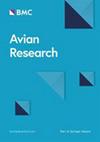个体和群体因素对虎皮鹦鹉社会关系的影响
IF 1.7
2区 生物学
Q1 ORNITHOLOGY
引用次数: 0
摘要
群居动物通常与群体成员形成动态关系,这与提高社会学习、生存和繁殖成功率有关。社会关系可以由群体和个人因素共同塑造;然而,很少有研究解决了它们的综合影响。在本研究中,我们旨在探讨群体因素和个人因素是否共同影响社会关系。本文以虎皮鹦鹉(Melopsittacus undulatus)为研究对象,探讨了虎皮鹦鹉性别、个性、体长以及性别比和群体大小对其社会关系的影响。结果表明,3个体组的攻击网络加权度值高于5个体组。异性群体中的个体比同性群体中的个体表现出更高的攻击性和亲和性互动水平。此外,尽管女性的攻击行为明显低于男性,但她们的社会地位更高。个体体长越长,攻击网络加权度值越高。研究结果表明,群体因素主要影响社会网络,而个体因素在社会关系的形成中起着重要作用。本文章由计算机程序翻译,如有差异,请以英文原文为准。
Effects of individual and group factors on the social relationships of Budgerigars
Social animals often form dynamic relationships with group members, which have been associated with increased social learning, survival and reproductive success. Social relationships can be shaped by both group and individual factors; however, few studies have addressed their combined impact. In this study, we aimed to examine whether group factors and individual factors jointly affect social relations. We selected Budgerigars (Melopsittacus undulatus) as the focal species to investigate the influence of sex, personality, and body length as well as sex ratio and group size on social relationships. The results showed that the birds in 3-individual groups had higher aggression network weighted degree values than those in 5-individual groups. Individuals within opposite-sex groups showed higher levels of aggressive and affiliative interactions than those in same-sex groups. Additionally, females attained higher social ranks despite exhibiting significantly lower aggression behaviors than males. Individuals with longer body lengths exhibited higher aggression network weighted degree values. Our results suggest that group factors primarily influence the social networks, while individual factors play important roles in shaping the social relationships.
求助全文
通过发布文献求助,成功后即可免费获取论文全文。
去求助
来源期刊

Avian Research
ORNITHOLOGY-
CiteScore
2.90
自引率
16.70%
发文量
456
审稿时长
46 days
期刊介绍:
Avian Research is an open access, peer-reviewed journal publishing high quality research and review articles on all aspects of ornithology from all over the world. It aims to report the latest and most significant progress in ornithology and to encourage exchange of ideas among international ornithologists. As an open access journal, Avian Research provides a unique opportunity to publish high quality contents that will be internationally accessible to any reader at no cost.
 求助内容:
求助内容: 应助结果提醒方式:
应助结果提醒方式:


